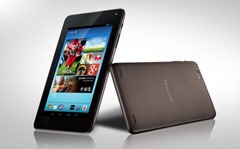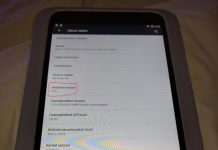 Whatever happened to the “$100 laptop”? On Engadget, Ross Rubin poses the question, looking at the original lofty goals of the OLPC to put computing in the hands of everyone for less than $100 and seeing what can be found in that range today. (Was that really all of seven years ago?) Now, of course, the “$100 laptop” is no longer a laptop at all.
Whatever happened to the “$100 laptop”? On Engadget, Ross Rubin poses the question, looking at the original lofty goals of the OLPC to put computing in the hands of everyone for less than $100 and seeing what can be found in that range today. (Was that really all of seven years ago?) Now, of course, the “$100 laptop” is no longer a laptop at all.
Back in 2006, Rubin tried to see what computers he could find at the $100 range, which consisted mostly of checking Ebay for computers that tended to have rather dubious pedigrees. This time around, he looked at the Hisense Sero LT, an Android tablet that can be had for $100 (or less) new.
It is, of course, not a laptop, but it’s even smaller and lighter than a laptop, and keyboards aren’t as necessary in the new tablet computing world anyway. It doesn’t run a desktop OS, but it has a good selection of apps that can now be used for almost as many things as a desktop computer.
Many of these apps aren’t as deep as those one would find on a Windows PC or Mac, but consider that consumers use PCs dramatically differently than they did seven years ago; that more app categories are becoming progressively (storage) or inherently (social networking) cloud-based, anyway. And high volumes and new software revenue models make many of them available for free or for a dollar or two.
It’s even available for less than $100, now, at a retail price of $79. (And you can get similar tablets even cheaper, as that $50 tablet I found at Office Depot or the $38 tablet Datawind’s going to bring out indicate.) And you can hook it up to a TV for streaming media. And it seems to get fairly decent reviews.
Of course, it’s really not that great of a tablet compared to the ones that cost even $150 or so (such as the $120 XO tablet, heir to the “$100 laptop” OLPC brand, which is neither $100 nor a laptop), let alone the more costly ones like the Nexus or Galaxy Tab. It lacks Bluetooth, only has 4 GB of onboard storage, and has a fairly poor battery life. But in terms of working at all for a low, low price, it’s not bad if that’s all the money you’ve got and you’re looking to walk into a store and walk out with a tablet.
Teleread contributor Nate Hoffelder has reviewed a number of budget tablets on his own blog, The Digital Reader. His current budget recommendation is the HP Mesquite, which he says is on par performance-wise with the Sero 7 Pro, for $50 less.
































Oy! If you’re going to talk about sub-$100 Android tablets then why not send them my way?
Over the past few months I have reviewed a bunch of tablets in that price range. My current favorite for best value is the HP Mesquite tablet. It has battery life and performance equal to the Hisense Sero 7 Pro and costs $50 less but is less pretty.
http://www.the-digital-reader.com/?p=60732
A fair point. Edited to stick it in.
With the XO, OLPC also strove to become independent of the unreliable electricity in developing countries by including a hand cranked generator (not unlike those used in US telephones in the early days). They also developed the Mesh network scheme to avoid dependance upon fee-based systems.
What tablets today do as well or better in avoiding these show stopping costs?
The OLPC project is not the wunderkind that you think it is. The original XO laptop failed miserably at being low power. The most recent model is a lot better, but it’s not anything spectacular either.
It might surprise you but there are any number of 7″ Android tablets that could match the 5 to 10 battery life of the XO-1.75 laptop (the current model). That includes the cheap tablet I mentioned above.
And do you know what? The XO-1.75 laptop came out in 2012 but you could find WinXP netbooks with similar battery life in 2010.
And as for the mesh network, here:
http://stackoverflow.com/questions/1932150/can-android-do-peer-to-peer-ad-hoc-networking
And the hand cranks turned out to be a lot less practical than expected, too.